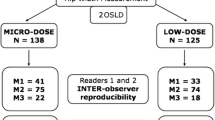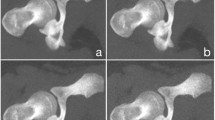Abstract
Purpose
To evaluate in children the agreement between femoral and tibial torsion measurements obtained with low-dose biplanar radiography (LDBR) and CT, and to study dose reduction ratio between these two techniques both in vitro and in vivo.
Materials and methods
Thirty children with lower limb torsion abnormalities were included in a prospective study. Biplanar radiographs and CTs were performed for measurements of lower limb torsion on each patient. Values were compared using Bland-Altman plots. Interreader and intrareader agreements were evaluated by intraclass correlation coefficients. Comparative dosimetric study was performed using an ionization chamber in a tissue-equivalent phantom, and with thermoluminescent dosimeters in 5 patients.
Results
Average differences between CT and LDBR measurements were –0.1° ±1.1 for femoral torsion and –0.7° ±1.4 for tibial torsion. Interreader agreement for LDBR measurements was very good for both femoral torsion (FT) (0.81) and tibial torsion (TT) (0.87). Intrareader agreement was excellent for FT (0.97) and TT (0.89). The ratio between CT scan dose and LDBR dose was 22 in vitro (absorbed dose) and 32 in vivo (skin dose).
Conclusion
Lower limb torsion measurements obtained with LDBR are comparable to CT measurements in children and adolescents, with a considerably reduced radiation dose.
Key points
• LDBR and CT lower-limb torsion measurements are comparable in children and adolescents.
• LDBR considerably reduced radiation dose necessary for lower-limb torsion measurements.
• LDBR can be used for evaluation of lower limb-torsion in orthopaediatric patients.





Similar content being viewed by others
Abbreviations
- CTDI:
-
Computed tomography dose index
- TLD:
-
radiothermoluminescent detectors
- DLP:
-
dose-length product
- LDBR:
-
Low dose biplanar radiography
- FT:
-
Femoral torsion
- TT:
-
Tibial torsion
References
Masson (2007) Anomalies rotationnelles des membres inférieurs chez l'enfant. EMC Appar Locomoteur 15:1–12
Kim HY, Lee SK, Lee NK, Choy WS (2012) An anatomical measurement of medial femoral torsion. J Pediatr Orthop B 21:552–557
Hernandez RJ, Tachdjian MO, Poznanski AK, Dias LS (1981) CT determination of femoral torsion. AJR Am J Roentgenol 137:97–101
Goutallier D, Van Driessche S, Manicom O et al (2006) Influence of lower-limb torsion on long-term outcomes of tibial valgus osteotomy for medial compartment knee osteoarthritis. J Bone Joint Surg Am 88:2439–2447
Rehani MM, Berry M (2000) Radiation doses in computed tomography. The increasing doses of radiation need to be controlled. BMJ 320:593–594
Dubousset J, Charpak G, Dorion I et al (2005) Une nouvelle imagerie ostéo-articulaire basse dose en position debout : le système EOS. Radioprotection 40:245–255
Kalifa G, Charpak Y, Maccia C et al (1998) Evaluation of a new low-dose digital x-ray device: first dosimetric and clinical results in children. Pediatr Radiol 28:557–561
Mathews JD, Forsythe AV, Brady Z et al (2013) Cancer risk in 680,000 people exposed to computed tomography scans in childhood or adolescence: data linkage study of 11 million Australians. BMJ 346:f2360
Buck FM, Guggenberger R, Koch PP, Pfirrmann CWA (2012) Femoral and tibial torsion measurements with 3D models based on low-dose biplanar radiographs in comparison with standard CT measurements. Am J Roentgenol 199:W607–W612
Bland JM, Altman DG (1986) Statistical methods for assessing agreement between two methods of clinical measurement. Lancet 1:307–310
Altman DG, Bland JM (1983) JSTOR: Journal of the Royal Statistical Society. Series D (The Statistician), Vol. 32, No. 3 (Sep., 1983), pp. 307-317. The statistician
Rosskopf AB, Ramseier LE, Sutter R et al (2014) Femoral and tibial torsion measurement in children and adolescents: comparison of 3D models based on low-dose biplanar radiography and low-dose CT. Am J Roentgenol 202:W285–W291
Dubousset J, Charpak G, Skalli W, et al. (2007) [EOS stereo-radiography system: whole-body simultaneous anteroposterior and lateral radiographs with very low radiation dose]. In: Rev Chir Orthop Reparatrice Appar Mot. pp 141–143
Illés T, Tunyogi-Csapó M, Somoskeöy S (2011) Breakthrough in three-dimensional scoliosis diagnosis: significance of horizontal plane view and vertebra vectors. Eur Spine J 20:135–143
Deschênes S, Charron G, Beaudoin G et al (2010) Diagnostic imaging of spinal deformities: reducing patients radiation dose with a new slot-scanning X-ray imager. Spine 35:989–994
Wade R, Yang H, McKenna C et al (2012) A systematic review of the clinical effectiveness of EOS 2D/3D X-ray imaging system. Eur Spine J 22:296–304
Thrall JH (2012) Radiation exposure in CT scanning and risk: where are we? Radiology 264:325–328
Sugier A, Lecomte JF, Nenot JC (2007) Les recommandations 2007 de la Commission internationale de protection radiologique. Revue générale nucléaire
Kenny N, Hill J (1992) Gonad protection in young orthopaedic patients. BMJ 304:1411–1413
Delin C, Silvera S, Bassinet C et al (2014) Ionizing radiation doses during lower limb torsion and anteversion measurements by EOS stereoradiography and computed tomography. Eur J Radiol 83:371–377
Faria R, McKenna C, Wade R et al (2013) The EOS 2D/3D X-ray imaging system: a cost-effectiveness analysis quantifying the health benefits from reduced radiation exposure. Eur J Radiol 82:e342–e349
Staheli LT (1993) Rotational problems in children. J Bone Joint Surg Am 75:939–949
Christe A, Heverhagen J, Ozdoba C et al (2013) CT dose and image quality in the last three scanner generations. World J Radiol 5:421–429
Acknowledgments
We have greatly appreciated the kind help and support of the whole Toulouse children hospital radiology department, especially Barjorie, Barracca, Maryse and Marie Claire.
The scientific guarantor of this publication is Dr Christiane Baunin. The authors of this manuscript declare relationships with the following company: ALRA Expertise. The authors of this manuscript declare no relationships with any companies whose products or services may be related to the subject matter of the article. The authors state that this work has not received any funding. One of the authors Dr Agnes Sommet has significant statistical expertise and provided statistical advice for this manuscript. Institutional Review Board approval was obtained. Written informed consent was waived by the Institutional Review Board. Methodology: prospective, observational and experimental on phantom, performed at one institution.
Author information
Authors and Affiliations
Corresponding author
Rights and permissions
About this article
Cite this article
Meyrignac, O., Moreno, R., Baunin, C. et al. Low-dose biplanar radiography can be used in children and adolescents to accurately assess femoral and tibial torsion and greatly reduce irradiation. Eur Radiol 25, 1752–1760 (2015). https://doi.org/10.1007/s00330-014-3560-8
Received:
Revised:
Accepted:
Published:
Issue Date:
DOI: https://doi.org/10.1007/s00330-014-3560-8




